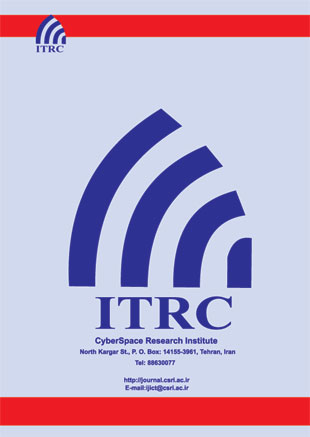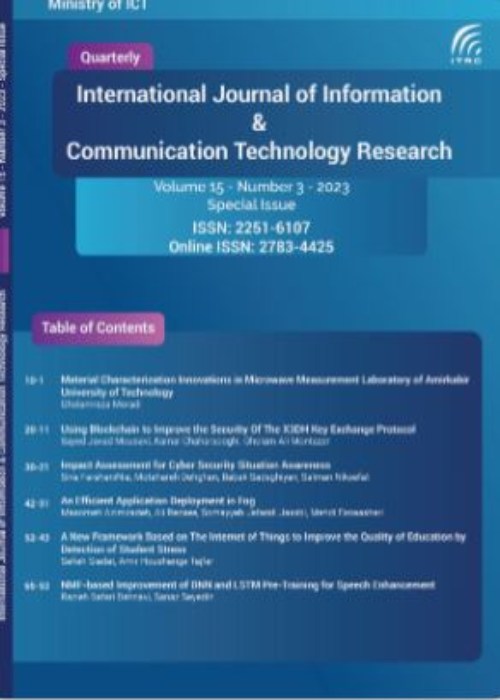فهرست مطالب

International Journal Information and Communication Technology Research
Volume:5 Issue: 4, Autumn 2013
- تاریخ انتشار: 1392/09/28
- تعداد عناوین: 8
-
-
Pages 1-7It has already been shown that in rate-constrained broadcast channels, under the assumption of independent Rayleigh, Rician and Nakagami fading channels for different receivers, the user capacity (i.e. the maximum number of users that can be activated simultaneously) scales double logarithmically with the total number of users. However, to achieve the aforementioned result, it is assumed that channel state information (CSI) is perfectly known to the receivers. In practical situations, the receivers do not have access to the true CSI and they only know estimated channels. In this paper, the effects of channel estimation is analyzed on the user capacity of rate-constrained broadcast channels. In particular, the Minimum Mean Square Error (MMSE) channel estimation scheme is considered and the effects of this estimation method on the user capacity is investigated. Under the assumption of commonly used fading channels for different receivers, it is shown that the user capacity still scales double logarithmically; however, there is a gap depending on channel estimators accuracy between the upper and lower bound of the user capacity. The bound will be asymptotically tight if the variance of the channel estimator remains constant. Index Terms—User capacity,channel estimation, scaling laws, broadcast channels, fading channels, minimum-rateconstraint, power allocation.
-
Pages 9-18Distributed Systems (DS) are usually complex systems composed of various components and cloud is a common type of DSs. Reliability is a major challenge for the design of cloud systems and DSs in general. In this paper an analytical model to analyze reliability in DSs with regards to task allocation was presented. Subsequently, this model was modified and a new model to analyze reliability in cloud systems with regards to Virtual Machine(VM) allocation was suggested. On the other hand, optimal task allocation in DSs is an NP-hard problem, thus finding exact solutions are limited to small-scale problems. This paper presents a new swarm intelligence technique based on Cat Swarm Optimization (CSO) algorithm to find near optimal solution. For evaluating the algorithm, CSO is compared with Genetic Algorithm (GA) and Particle Swarm Optimization (PSO). The experimental results show that in contrast to PSO and GA, CSO acquires acceptable reliability in reasonable execution time.Keywords: distributed system, reliability, cat swarm optimization, cloud computing, task allocation, analytical model
-
Pages 19-26We present an approach for maximum likelihood (ML) parameter estimation of the Gamma-Gamma (Г-Г) distribution in the weak turbulence conditions of the free space optical (FSO) channels. A two-dimensional ML (2DML) estimation approach is deployed to extend our one-dimensional Г-Г parameter estimation (1DML) method proposed in [1]. To achieve the 2D estimation, an explicit closed form expression between the Г-Г parameters is extracted, where the constant factors of the expression are obtained using genetic algorithm (GA). The proposed 2DML estimation is compared with the modified method of moments based on a convex optimization (modified MOM/CVX). The numerical results demonstrate that 2DML outperforms modified MOM/CVX in terms of the mean square error of the estimation and the variance of the estimators. Moreover, the convergence rate of the 2DML method is high and not sensitive to the starting points.Keywords: Maximum Likelihood Estimation, Free Space Optical (FSO), Gamma, Gamma Distribution, Genetic Algorithm
-
Pages 27-35According to the popularity of variant video streaming applications over the Internet, video quality assessment is essential for video solutions and network operators in order to evaluate video stream quality and measure the end-user Quality of Experience. Packet loss affects both the decoder performance and the user’s perception of video quality due to several network issues. The main goal of this paper isto estimate the perceived video quality at the receiver’s side by passive measurement in the network and also evaluate how errors propagate through temporal prediction. Our proposed method is based on the network level parameters by considering the video codec and frame information. Our experimental analysis shows the accuracy and efficiency of the proposed method.Keywords: Video Quality Estimation, Passive Traffic Measurement, Packet Lost Evaluation
-
Pages 37-45We present a novel method of face verification which is based on the concept and principles of sparse representation of signals. The sparse representation techniques are used in both feature extraction and classification steps. The proposed method is relatively invariant to changes in imaging conditions such as illumination variations. This is due to the characteristics of the sparse sampling method. In order to improve the invariance properties of the system, the feature extraction algorithm is motivated by using the Local Binary Pattern (LBP) features. Our experimental studies on the XM2VTS and XM2VTS-DARK datasets demonstrate that the proposed method improves the performance of the verification system.Keywords: Face Verification, Sparse Representation, Sparsity Preserving Projection (SPP), Sparse Representation Classifier (SRC), Local Binary Pattern(LBP)
-
Pages 47-58Recent efforts in machine translation try to enrich statistical methods by syntactic information of source and target languages. In this paper we present a hybrid machine translator, which combines rule-based and statistical models in a serial manner. This system uses synchronous tree adjoining grammar (STAG) to benefit the context sensitivity of this formalism. In this system, a set of reordering rules in STAG formalism is automatically extracted from a parallel corpus. These rules are used to change the word orders of the source sentence to match the word ordersin the target language. The restructured sentences are then translated to target language using a statistical approach. Experiments are carried out on three different datasets for English-Persian translation. Experimental results show that the presented reordering method combined with conventional or monotone phrase-based SMT, improves the translation quality respectively by 1.8 and 0.55 points regarding BLEU score.Keywords: Statistical Machine Translation, Reordering Rules, Tree Adjoining Grammar
-
Pages 59-69Volunteer computing is a type of parallel computing systems that is defined by a large number of nodes and autonomous changeable resources. Task scheduling is one of the most crucial issues on volunteer computing. A welldefined scheduling attracts the versatile guest applications to submit their jobs to this environment and motivates internet-users to contribute more. Hence, optimization of the server-side policies will stimulate volunteers’ eagerness to contribute more of their resources. The existent methods cannot use the capacity of the host system efficiently. In this paper, we propose a new scheduling mechanism, which tries to decrease the idleness factor of the host system and keeps down its waste factor. In our method, we schedule some of the jobs in one RPC round earlier than usual. The experimental results show that the total efficiently executed work increases up to 70% and the average increases by 35%. Keywords-Keywords: volunteer cmputing, scheduling mechanism, remote procedure call, EDF algorithm
-
Page 70This electronic document is a “live” template. The various components of your paper [title, text, heads, etc.] are already defined on the style sheet, as illustrated by the portions given in this document. (Abstract should not be longer than 150 words).Keywords: component_formatting_style_styling_insert (Include 5 to 10 words. )


